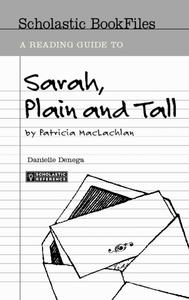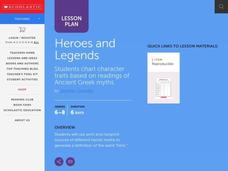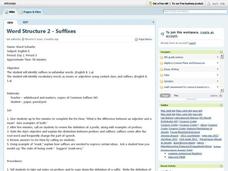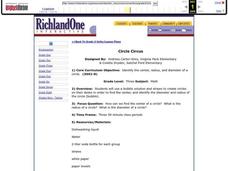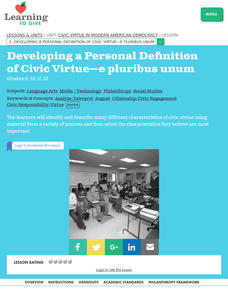American Chemical Society
Defining Dissolving
Physical science investigators mix sugar and food coloring into different cups of water and cooking oil to compare how the solid and liquid behave in each. As the introduction to this unit on dissolving, it is relevant.
Scholastic
A Reading Guide to Sarah, Plain and Tall
Eliminate the hard work of creating an entire literature unit with this reading guide for the novel Sarah, Plain and Tall. From background information about the author and her motivation for writing the story to...
Curated OER
Word of the Day
For this vocabulary worksheet, students are provided an area to record new words they encounter during the day. Students record the word, definition, part of speech and use it in a sentence.
Curated OER
Heroes and Legends
Young scholars use print and nonprint sources of different heroic myths to generate a definition of the word "hero." They conduct a character study on three mythological heroes and formulate a definition of the word "hero" based on...
Curated OER
Word Structure 2 - Suffixes
Eighth graders identify suffixes in unfamiliar words. They identify vocabulary words as nouns or adjectives using context clues and suffixes. They review the definition of a prefix, along with examples of prefixes and explain the...
Curated OER
Greek and Latin Roots Lesson Plan: Create a Super Hero!
Students create a new super hero based on their knowledge of root words. In this word roots and origins lesson, students choose a Latin or Green root word to use as part of their super here name, then create a drawing and description of...
Curated OER
Math Bingo
Students practice using mathematical vocabulary by playing a class game. In this math comprehension lesson plan, students investigate a group of math vocab words and their definitions, then create a bingo card using the Internet....
Curated OER
Miss Nelson is Missing / Miss Nelson Is Back- Lesson 2
Students read and analyze a story. In this compare and contrast lesson plan, students re-read Miss Nelson is Missing and use a Venn Diagram to compare and contrast Miss Nelson and Miss Viola Swamp. Students write about their...
Curated OER
Ecosystems: A Home By Any Other Name
Students can learn more about the parts of ecosystems through exploration and hands on activities.
Curated OER
Introduction to Conic Sections
Learners slice cones and identify the different conics formed. They then derive the formula to solve problems involving cones. Pull out the TI calculators to visualize the slicing and the different parts and properties created.
Curated OER
FOREST GRUMP: Examining How Deforestation Affects Plants and Animals of the Canadian Boreal
Students consider definition of an ecosystem as it relates to the Canadian boreal, discover how deforestation affects this forest and recreate ecosystems. They write persuasive letters urging politicians or business people to help save...
Curated OER
Are Viruses Alive: Sample Socratic Questions
Students comprehend the definition and uniqueness of life and its complexities. They examine what characteristics constitute a living organism. Students recognize the extent of the role viruses play in the movement and molding of life as...
Curated OER
Similar Figures
Your class will use a TI calculator to drag vertices of rectangles and triangles to observe what happens to ratios of pairs of sides within each figure. They will apply the definition of similarity to identify similar shapes. The...
Curated OER
Climate Mime-it
Students pantomime new climate vocabulary words. For this climate lesson, students go over new vocabulary words and their meanings. Students form groups and pantomime these word's definitions.
Curated OER
Biogeochemical Cycles
Middle schoolers demonstrate comprehension of the energy sources of various cycles by completing mini stories. They demonstrate analysis of words by defining individual word parts and combining them to form definitions. Students...
Curated OER
Circle Circus
Third graders find the radius and diameter of a bubble. In this radius and diameter lesson, 3rd graders create bubbles on their desk and find the radius and diameter of the bubble. Students work in partners to define circle terms and...
Curated OER
The Quirky Quadrilateral
Fourth graders identify and classify different triangles and quadrilaterals. Then they demonstrate an understanding of plane and solid geometric objects and use this knowledge to show relationships and solve specific problems. Students...
Curated OER
Mixtures, Solutions and Matter
In this mixtures, solutions and matter worksheet, students are given 12 terms and they cut out 12 definitions to match with the terms. Topics include types of mixtures, types of matter such as atoms, molecules and compounds and solutions.
Curated OER
Civic Virtue in Democracy
Students identify and describe characteristics of civic virtue. Following a class discussion, they create their own definitions of civic virtue. They write essays based on their own definitions and formulate conclusions on the state of...
Curated OER
Movie Genres
For this grammar worksheet, students match twelve movie genres with their appropriate definitions and examples from two answer banks and then translate the titles into Chinese. Students answer six questions regarding personal movie...
Curated OER
Robot Gears
Learners build simple gear trains and record data to discover how to compute gear ratios. They investigate the definition of torque and how torque can be increased or decreased in a gear train.
Curated OER
Compounds and Mixtures
In this compounds learning exercise, learners draw a line to match the word with the definition. Students also match foods with their correct term.
Curated OER
Word Detective
In this word analysis worksheet, students use the graphic organizer to copy the sentence where the word was found, identify the context clues, the part of speech, create a personal definition and sentence, and draw a picture of its...
Curated OER
NEWTON'S 3RD LAW
High schoolers examine the formal definition of Newton's 3rd law: "forces always originate in pairs, equal in magnitude and opposite in direction." --The informal, qualitative version: "Each action has an equal and opposite reaction."

